Approaching carbon neutral on a sheep and agroforestry farm
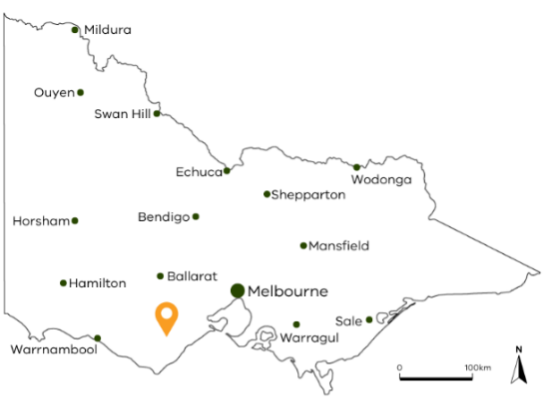
About Yan Yan Gurt West farm
- The Stewart family – Jill, Andrew, Hugh, siblings and the next generation – are lamb and agroforestry producers based in the foothills of the Otway Ranges near Deans Marsh in southern Victoria.
- Yan Yan Gurt West farm is 230 ha and includes grazing for prime lamb production, agroforestry, and applies regenerative farming practices.
- 1300 breeding ewes produce 1600 to 1800 lambs annually.
- The rolling hills of Deans Marsh consist of mostly brown and yellow textured contrast soils.
- The average annual rainfall is 680 mm.
- The family has planted more than 55,000 trees and shrubs across 18% of the farm, a total of 42 ha including 22 ha of agroforestry and 20 ha of biodiverse plantings.
- Lambing occurs late July for the mature ewes and September for the one-year-old maidens.
Farming and carbon emissions
In Australia, there’s a big focus on how farms manage greenhouse gas (GHG) emissions and store carbon. Efficient production to manage and reduce emissions is becoming increasingly important.
Agriculture Victoria’s On-Farm Emissions Action Plan Pilot is working with Victorian farmers to know, understand, and act on their farm GHG emissions.
The Stewarts have been running their farm with a focus on sustainability for many years. They work with like-minded people within Landcare and agroforestry. The Pilot program is helping them to benchmark the emissions footprint of their farm.
A recent report by Agriculture Victoria showed that the greenhouse gas emissions from our sheep farm, in the 2022/23 financial year, were more than offset by the amount of carbon locked up by the trees our family has planted over the last 30 years

European settlers arriving at Yan Yan Gurt in 1838 had cleared most of the original trees and forest in the area for grazing within 50 years, where about 3% of woody vegetation remained.
This left the landscape exposed and caused waterlogging, rising salinity and soil erosion. The ecology declined and there was a lack of shade and shelter for farm and native animals.
The Stewarts developed a whole farm plan in the early 1990s. The plan included the objectives of the management plan for the Yan Yan Gurt creek catchment, developed by the East Otway Landcare Group with some input from the Otway Agroforestry Network.
A key element of the design was fencing and tree planting along land-class boundaries. The plan included planting trees along creeks, drainage lines, plus fencing salt-affected areas and protecting remnant trees. The Stewarts also fenced around water holes leaving access points or applying gravity fed troughs for stock.
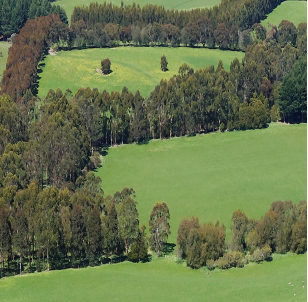
The tree plantings are linked together to form a web of connected trees and shrubs throughout the farming system including linkages with neighbours, thus forming ecological corridors throughout the landscape. Some of the trees and shrubs in these plantings are grown for wood and other products as part of the farm agroforestry system.
Over 30 years, the area covered by trees and shrubs on the farm has increased from 3 to 18% of the farm area, a total of 55,000 trees and shrubs. ‘Interestingly, increasing tree cover has not reduced our agricultural production’, said Andrew.
The farm has a strong focus on production efficiency through using pregnancy scanning and maximising lamb survival which ranges from 85 to 95% for twins and singles, respectively. Sheep genetics, drench efficacy testing, rotational grazing, autumn saving and set stocking at lambing are also important. Fertiliser and lime is added to pasture based on recurring soil testing. Soil organic carbon is also monitored and ranges from 2.5 to 4.5% in the topsoil (0-10 cm).
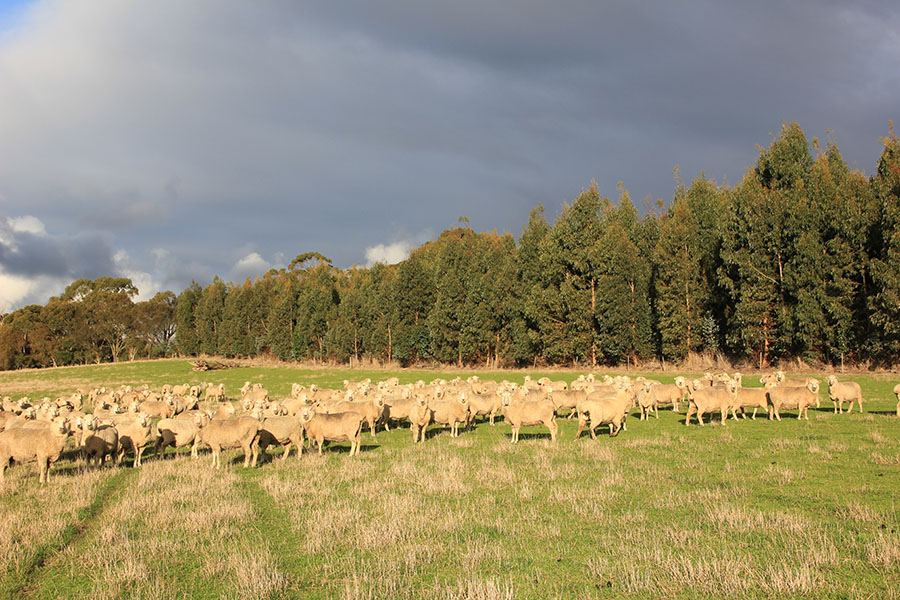
Know Your Number
‘Know Your Number’ is a way to measure the greenhouse gas (GHG) emissions from a farm using a special tool like the Greenhouse Accounting Framework (GAF) calculator.
This number is the total amount of carbon dioxide equivalents (CO2-e) produced by the farm each year. It includes three types of emissions, called Scopes:
- Scope 1: Emissions from livestock (like enteric methane from sheep and cows), nitrous oxide from nitrogen fertilizer application, urine and dung and carbon dioxide from fossil fuel use.
- Scope 2: Emissions resulting from the electricity the farm uses.
- Scope 3: Emissions created in manufacturing products the farm buys (embedded).
Farms can also capture and store carbon in trees and soils, a process known as carbon sequestration. This captured carbon can be used to balance against their emissions, which is called ‘insetting’.
On the Stewarts farm, about 86% of total farm emissions come from enteric methane produced by their sheep.
The farm’s 42 ha of trees provided a carbon sequestration inset against almost 98% of their farm emissions, which means the farm is almost net zero during the assessment. The tree belts were estimated to capture 628 tonnes CO2-e per year.
The rate of carbon capture and storage in 2021 was estimated to range from 4.7 tCO2-e/ha for tree and shrub plantings and up to 23.9 tCO2-e/ha for the agroforestry sections. The agroforestry plantings stored more carbon because the radiata pine, blue gum and spotted gum in these plantings all have high growth rates as commercial trees. Overall, agroforestry contributed 85% of the total carbon that was stored across all their farm tree plantings.
Acting to reduce emissions
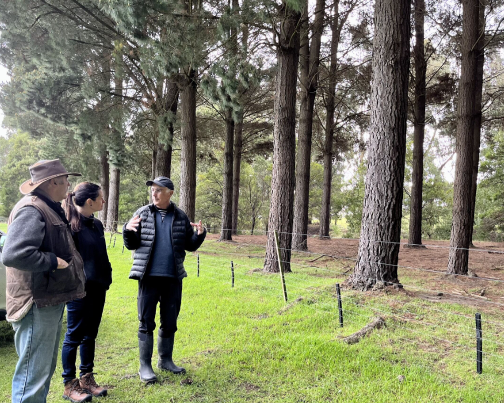
The Stewarts are also keen to showcase the advantages of agroforestry. Hugh Stewarts professional forestry experience was valuable, where he measured the trees to obtain a more accurate estimate of carbon being stored. Hugh was able to show that the amount of carbon being sequestered on their farm was more than twice what the standard carbon tool had initially estimated.
Carbon is sequestered on-farm as the agroforestry trees grow, with annual carbon sequestration usually being faster in the first decade of tree growth. A benefit of agroforestry is that when the trees reach maturity, they can be harvested for timber with carbon locked away in timber products in buildings and furniture. Agroforestry provides both a source of farm income and distributes the carbon throughout the economy minimising the risk of carbon losses from bushfires.
The future
The Stewarts are aiming for 20% tree cover on the farm in the future. They also plan to continue developing deep-rooted, multi-species pasture systems, including trialling of chicory and plantain, which also reduce enteric emissions from grazing sheep. Through sheep genetics, feed optimisation and live-weight monitoring of their sheep, they hope to reduce turn-off time which in turn will decrease the emissions intensity of their livestock.
Finally, Andrew said ‘Regenerative agriculture is about building more biodiversity and better ecological functionality with a view to emerging technologies to reduce our carbon footprint on the property as much as possible. The carbon account for the farm (all emissions and sequestration arising within the operational boundary of the farm) showed that the farm enterprise was carbon neutral in 2022-2023’.
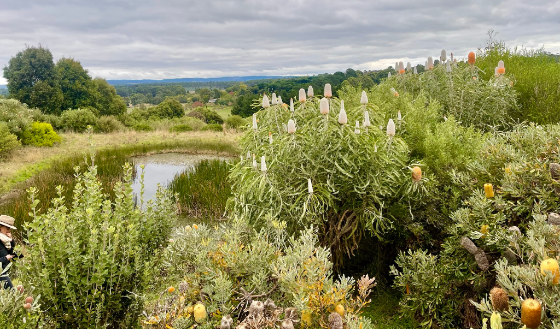
This case study is part of a series outlining practical actions Victorian farmers are implementing on farm as part of the Agriculture Victoria, On-Farm Emissions Action Plan Pilot program.
Acknowledgements
Author – James Nuttall, Agriculture Victoria, 2024
For further information on the project email actionplanpilot@agriculture.vic.gov.au
The On-Farm Emissions Action Plan Pilot is part of the Victorian Government’s Agriculture Sector Emissions Reduction Pledge to provide practical information, tools and services to support farmers to understand and reduce emissions. The Pilot will work with up to 250 farm businesses across the state to estimate their on-farm emissions profile and identify potential actions to manage and reduce emissions while maintaining productivity and profitability.